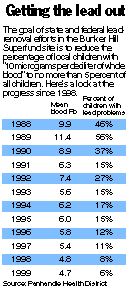Lead's dangers range from bad to
worst,
especially for children
By Ken Miller
The Idaho Statesman
 |
|
| An invisible threat
Lead can be taken into the body in several ways. In the Silver Valley,
lead-reduction efforts are focused on removing lead from soils, from homes
and other buildings.
People can swallow lead-tainted soil when dirty hands touch food or
cigarettes that are placed in mouth.
People can breathe dust carried in air or swallow dust that has settled
on objects such as dishes.
People can breathe or swallow dust particles while digging or working
in soil.
Children can place dusty fingers or other objects in mouth while playing. |
 |
|
|
It's likely that no town knows more about the dangers of lead contamination
than Kellogg, where living with lead has become routine.
For generations, the highly toxic element has been dumped into the area's
streams and rivers and onto its soil, and sent wafting through homes, schools
and other buildings in the form of nearly invisible dust. Time after time,
homes in this region have been cleaned to meet federal safety guidelines,
but inevitably the lead would return -- sometimes within a month.
While the Bunker Hill smelter site was placed on the Environmental Protection
Agency's Superfund list of the nation's most polluted areas because of
a number of toxic pollutants, lead is the most prevalent and the most troubling
to health officials.
There have been no reports of children showing such signs of lead poisoning
as diminished mental ability, but state and federal health officials say
the extraordinary levels of lead in the area during the 1970s has put some
children at risk of problems later in life. Much of the contamination took
place years ago, before such toxic releases were outlawed. Local citizens
haven't sued the mining industry for the poisoning, but the Coeur d'Alene
Tribe and the U.S. Department of Justice have, and that's the pending suit
that is prompting the EPA to consider the area a federal Superfund site.
Children are especially at risk from lead exposure because their high
growth rates make them vulnerable to absorbing more lead for their size
than adults.
While lead poisoning can harm almost all body systems, it is especially
dangerous to the developing brain and nervous systems of youngsters. At
high levels, lead exposure can be fatal. Children exposed to high levels
of lead can suffer from decreased mental abilities, learning difficulties
and stunted growth. The body has no use for lead, which can inhibit its
ability to absorb beneficial vitamins and minerals.
Nationwide, lead exposure often came from the burning of leaded gasoline,
from paints that contain lead in older homes, and from drinking water coming
from lead pipes.
Testing for lead exposure is best done through blood tests. The Centers
for Disease Control and Prevention recommends annual screening for children,
especially those 6 or younger.
While lead is difficult to detect, there are ways to reduce exposure:
* Hands should be washed frequently, especially before touching any
food. Fresh fruit and vegetables should be rinsed in cool water.
* Food shouldn't be stored in open containers, and diets should include
foods low in fat (fatty foods can cause a child's body to retain lead)
and high in calcium, iron, and zinc.
* Homes should be kept as free of dust as possible, particularly homes
built before 1978 that may have lead paint.
|

